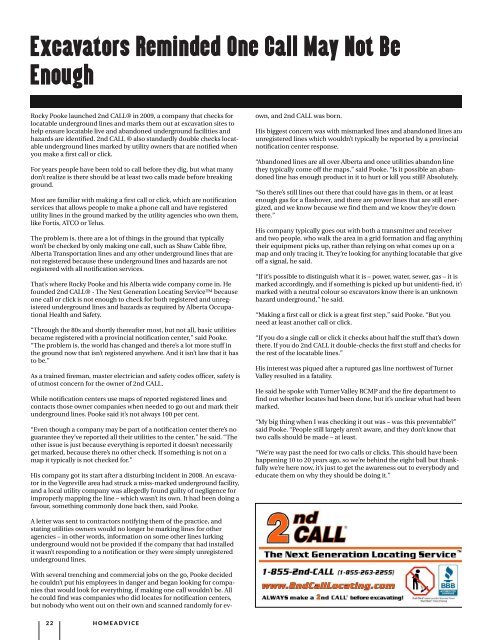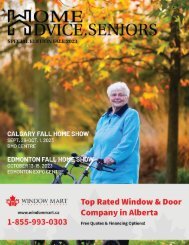Edmonton Spring 2023
Create successful ePaper yourself
Turn your PDF publications into a flip-book with our unique Google optimized e-Paper software.
Excavators Reminded reminded One Call one May call Not may Be not<br />
Enough be enough<br />
Rocky Pooke launched 2nd CALL® in 2009, a company that checks for<br />
locatable underground lines and marks them out at excavation sites to<br />
help ensure locatable live and abandoned underground facilities and<br />
hazards are identified. 2nd CALL ® also standardly double checks locatable<br />
underground lines marked by utility owners that are notified when<br />
you make a first call or click.<br />
For years people have been told to call before they dig, but what many<br />
don’t realize is there should be at least two calls made before breaking<br />
ground.<br />
Most are familiar with making a first call or click, which are notification<br />
services that allows people to make a phone call and have registered<br />
utility lines in the ground marked by the utility agencies who own them,<br />
like Fortis, ATCO or Telus.<br />
The problem is, there are a lot of things in the ground that typically<br />
won’t be checked by only making one call, such as Shaw Cable fibre,<br />
Alberta Transportation lines and any other underground lines that are<br />
not registered because these underground lines and hazards are not<br />
registered with all notification services.<br />
That’s where Rocky Pooke and his Alberta wide company come in. He<br />
founded 2nd CALL® - The Next Generation Locating Service because<br />
one call or click is not enough to check for both registered and unregistered<br />
underground lines and hazards as required by Alberta Occupational<br />
Health and Safety.<br />
“Through the 80s and shortly thereafter most, but not all, basic utilities<br />
became registered with a provincial notification center,” said Pooke.<br />
“The problem is, the world has changed and there’s a lot more stuff in<br />
the ground now that isn’t registered anywhere. And it isn’t law that it has<br />
to be.”<br />
As a trained fireman, master electrician and safety codes officer, safety is<br />
of utmost concern for the owner of 2nd CALL.<br />
While notification centers use maps of reported registered lines and<br />
contacts those owner companies when needed to go out and mark their<br />
underground lines. Pooke said it’s not always 100 per cent.<br />
“Even though a company may be part of a notification center there’s no<br />
guarantee they’ve reported all their utilities to the center,” he said. “The<br />
other issue is just because everything is reported it doesn’t necessarily<br />
get marked, because there’s no other check. If something is not on a<br />
map it typically is not checked for.”<br />
His company got its start after a disturbing incident in 2008. An excavator<br />
in the Vegreville area had struck a miss-marked underground facility,<br />
and a local utility company was allegedly found guilty of negligence for<br />
improperly mapping the line – which wasn’t its own. It had been doing a<br />
favour, something commonly done back then, said Pooke.<br />
With several trenching and commercial jobs on the go, Pooke decided<br />
he couldn’t put his employees in danger and began looking for companies<br />
that would look for everything, if making one call wouldn’t be. All<br />
he could find was companies who did locates for notification centers,<br />
but nobody who went out on their own and scanned randomly for evown,<br />
and 2nd CALL was born.<br />
His biggest concern was with mismarked lines and abandoned lines and<br />
unregistered lines which wouldn’t typically be reported by a provincial<br />
notification center response.<br />
“Abandoned lines are all over Alberta and once utilities abandon line<br />
they typically come off the maps,” said Pooke. “Is it possible an abandoned<br />
line has enough product in it to hurt or kill you still? Absolutely.<br />
“So there’s still lines out there that could have gas in them, or at least<br />
enough gas for a flashover, and there are power lines that are still energized,<br />
and we know because we find them and we know they’re down<br />
there.”<br />
His company typically goes out with both a transmitter and receiver<br />
and two people, who walk the area in a grid formation and flag anything<br />
their equipment picks up, rather than relying on what comes up on a<br />
map and only tracing it. They’re looking for anything locatable that gives<br />
off a signal, he said.<br />
“If it’s possible to distinguish what it is – power, water, sewer, gas – it is<br />
marked accordingly, and if something is picked up but unidenti-fied, it’s<br />
marked with a neutral colour so excavators know there is an unknown<br />
hazard underground,” he said.<br />
“Making a first call or click is a great first step,” said Pooke. “But you<br />
need at least another call or click.<br />
“If you do a single call or click it checks about half the stuff that’s down<br />
there. If you do 2nd CALL it double-checks the first stuff and checks for<br />
the rest of the locatable lines.”<br />
His interest was piqued after a ruptured gas line northwest of Turner<br />
Valley resulted in a fatality.<br />
He said he spoke with Turner Valley RCMP and the fire department to<br />
find out whether locates had been done, but it’s unclear what had been<br />
marked.<br />
“My big thing when I was checking it out was – was this preventable?”<br />
said Pooke. “People still largely aren’t aware, and they don’t know that<br />
two calls should be made – at least.<br />
“We’re way past the need for two calls or clicks. This should have been<br />
happening 10 to 20 years ago, so we’re behind the eight ball but thankfully<br />
we’re here now, it’s just to get the awareness out to everybody and<br />
educate them on why they should be doing it.”<br />
A letter was sent to contractors notifying them of the practice, and<br />
stating utilities owners would no longer be marking lines for other<br />
agencies – in other words, information on some other lines lurking<br />
underground would not be provided if the company that had installed<br />
it wasn’t responding to a notification or they were simply unregistered<br />
underground lines.<br />
22 HOMEADVICE

















